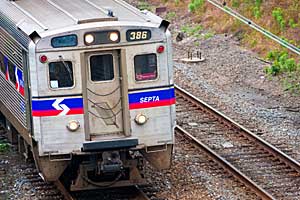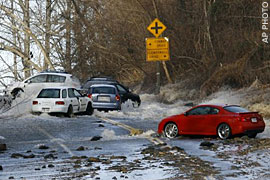America's Failing Infrastructure: A Scary Picture
Just how safe is the bridge you crossed on your way to work today? You may not want to know.

Federal, state and local spending on public works projects is already woefully shy of what it should be to keep bridges, roads, dams and other infrastructure up to snuff. But the sluggish economy is forcing even more project delays and cancellations, exacerbating America’s infrastructure crisis.
Take a look at funding levels for bridges, highways, dams, subways, seaports, public schools, electricity transmission and drinking water systems. The level of attention being paid to each is also reflected in letter grades given by the American Society of Civil Engineers.
Beware: The grades aren’t pretty.
From just $107.88 $24.99 for Kiplinger Personal Finance
Become a smarter, better informed investor. Subscribe from just $107.88 $24.99, plus get up to 4 Special Issues

Sign up for Kiplinger’s Free Newsletters
Profit and prosper with the best of expert advice on investing, taxes, retirement, personal finance and more - straight to your e-mail.
Profit and prosper with the best of expert advice - straight to your e-mail.
Bridges
Number of Bridges in the U.S.: 590,766
Number of Deficient Bridges: 152,316
Current Spending: $5.2 billion annually
Ideal Spending: $19 billion annually over a 50-year period
Grade: C
The big wave of bridge building in the 1950s and 1960s created spans built to last half a century. For many of them, time’s up. The average age of bridges in America stands at 43. And the American Association of State Highway and Transportation Officials (AASHTO) says that, while still safe, nearly one in four bridges is either structurally deficient and in need of repair or too narrow for today’s traffic volumes.
Narrow bridges built for yesteryear’s traffic impede commuting and other travel times as well as the timely delivery of goods, emergency services, etc. Large interchanges and river crossings are major choke points.

The top 10 highway interchange bottlenecks in the nation -- including the crossing of Interstates 90 and 290 in Buffalo, N.Y., and I-285 and I-85 in Atlanta -- delay truck shipments by an average of 1.5 million hours a year, AASHTO notes.
Of course, the consequences of a bridge failure can be even more devastating. The I-35W bridge in Minneapolis that collapsed into the Mississippi River in 2007 killed 13 people and caused massive commuting headaches for many months.
Highways
Number of Highway Miles in the U.S.: 47,013
Current Spending: $42 billion annually
Ideal Spending: $146 billion to $310 billion annually over a 15- to 50-year period
Grade: D-
America’s highways are buckling under levels of traffic that were unforeseen by the engineers who designed them. Serving as Americans’ top mode of transportation, major highways are also vital to freight transportation.One proposed fix: raising the gasoline tax and dedicating the revenues to highway repairs. Hiking the federal gasoline tax by 10¢ a month would cost each American household about $9 per month. But such a move has never gained traction with voters, and odds of it happening remain slim to none.
Dams
Number of Dams in the U.S.: 84,000
Number of Deficient Dams: 4,400
Current Spending: $1 billion annually
Ideal Spending: $54 billion annually
Grade: D
Aging dams are another brewing problem. Over a third of the nation’s dams are 50 years old, and in 10 years, nearly 70% of dams in the U.S. will have reached the half century mark, according to the Association of State Dam Safety Officials (ASDSO).
Moreover, more dams are now deemed high risk because of population encroachment. With infrastructure aging and insufficient funds to fully back state safety inspections and safety plans, deficient dams could cause catastrophic floods that would be deadly for nearby residents and farms as well as entities that rely on hydropower.
Unfortunately, part of the problem is deciding who is responsible for rehabilitating dams. Most dams are privately owned but state regulated. The benefits a private owner may receive fall far short of the cost of repairs or complete rehabilitation. And the clock is ticking. The ASDSO reports that putting off needed repairs for 15 years would likely make them five to 10 times more costly.
Subways
Number of City Subway Systems in the U.S.: 11
Current Spending: More than $60 billion over a six-year period
Ideal Spending: $123 billion over a six-year period
Grade: D

The nation’s transit system is falling behind in repairs and scraping by with what little funds are left. Philadelphia desperately needs funds for its aging subway system, which was constructed in the early 1900s and 1920s. The system relies on power substations, most of which are close to 80 years old. If all of them fail, the whole system could go down, since there isn’t enough money to fix it. It makes Philly an example of making do with what you’ve got, not unknown in many other cities.
The subway is very important to business in Philadelphia. About 70% of the people who use the system do so to reach their offices downtown.
The only way to keep America’s subway systems operating at full speed is through fares. According to the American Public Transportation Association (APTA), 80% of transit systems have been forced to implement fare increases or defer maintenance.
Schools
Number of Public Schools in the U.S.: 94,000
Current Spending: About $20 billion annually
Ideal Spending: At least $254 billion to fix all schools
Grade: D
They don’t transport people or goods, but public schools constitute a critical segment of America’s physical infrastructure. The quality of the nation’s future workforce depends on the education being provided in thousands of public schools right now.
Unfortunately, the physical condition of the country’s public schools leaves much to be desired. Many are old and decrepit, needing significant renovation or outright replacement. A 2008 study prepared by education finance experts David C. Thompson of Kansas State University and Faith E. Crampton, president and CEO of education consultancy Crampton & Associates in Milwaukee, Wis., pegged the cost of replacing or refurbishing America’s public schools at $254 billion.
And in light of the sharp recession of 2008 and 2009, Crampton figures that the number has only gone up, as school budgets have tightened and necessary maintenance work often gets deferred. Local tax increases -- the usual source of funding for school construction -- are a particularly tough sell, she says.
Ports
Number of Commercial Seaports in the U.S.: 360
Current Spending: About $850 million annually
Ideal Spending: About $1.8 billion annually
Grade: D-
President Obama hopes that strong growth in U.S. exports can help the economy out of the doldrums. But unfortunately, many of the nation’s ports aren’t keeping up with routine maintenance needed to keep their channels wide and deep enough for current shipping. Kurt Nagle, president of the American Association of Port Authorities, sees “dramatic shortfalls” in spending on channel dredging and other vital navigation work.
The Army Corps of Engineers handles those duties, and the federal government taxes all incoming cargo to fund the corps’ work keeping shipping lanes cleared of silt and deep enough for big freighters. But Uncle Sam routinely holds back half the funds that the tax generates to make the federal deficit look smaller, meaning the corps often has to delay channel dredging and widening.
The shortfall, which Nagle pegs at more than $500 million per year, doesn’t even account for new port projects, such as deepening channels so they can handle the giant container ships expected to reach the Atlantic Ocean from Asia when the Panama Canal is expanded in 2014. If U.S. seaports aren’t ready to welcome those giant freighters, other nations’ seaports will, Nagle warns.
Drinking Water
Number of Public Water Systems in the U.S.: 52,000
Current Spending: $29 billion annually
Ideal Spending: At least $335 billion to update all systems
Grade: D-

The pipes that deliver drinking water to most American homes are usually buried underground. So most folks probably don’t realize just how old some of them are: Many drinking water systems in Eastern cities date back to the late 19th century. Upgrading them is paramount, and that will spell higher water bills for businesses and homeowners. But Tom Curtis, deputy executive director of the American Water Works Association, warns, “We ignore this at our peril.”“It’s a public safety issue, it’s a public health issue, and it’s an economic issue,” Curtis says. Water main breaks can cut pressure to fire hydrants and hoses and cause other problems, such as the risk of bacteria and toxins creeping into a city’s water supply as well as flooding. For example, a broken water main in Bethesda, Md., in 2008 led to travel disruptions and school closings.
The Electric Grid
Miles of High-Voltage Transmission Lines in the U.S.: 157,000
Current Spending: About $30 billion annually
Ideal Spending: $338 billion to modernize the grid
Grade: D+
Most folks think of power outages as minor inconveniences -- times to fumble in the dark for flashlights and to worry about milk in the fridge going bad. But the U.S. electric grid is vulnerable to far larger disruptions, either from failures in America’s aging electric infrastructure or from deliberate cyberattacks by computer hackers looking to cause mayhem. Either way, a massive blackout could potentially cripple large portions of the country and cost billions of dollars.
There’s lots of talk about making the electric grid “smarter” by upgrading to new transmission equipment that can quickly detect and respond to outages while fending off online infiltrators. But building a truly smart grid would take years, and the price tag would be steep. However, the costs of not bulking up the electric grid are steep, too. For instance, the Electric Power Research Institute calculates that major blackouts, like the one that hit much of the Northeast in 2003, cost $10 billion each, and that total costs related to “power disturbances” sap the U.S. economy of at least $104 billion per year due to factory outages, work interruptions and the like.
Profit and prosper with the best of Kiplinger's advice on investing, taxes, retirement, personal finance and much more. Delivered daily. Enter your email in the box and click Sign Me Up.

Jim joined Kiplinger in December 2010, covering energy and commodities markets, autos, environment and sports business for The Kiplinger Letter. He is now the managing editor of The Kiplinger Letter and The Kiplinger Tax Letter. He also frequently appears on radio and podcasts to discuss the outlook for gasoline prices and new car technologies. Prior to joining Kiplinger, he covered federal grant funding and congressional appropriations for Thompson Publishing Group, writing for a range of print and online publications. He holds a BA in history from the University of Rochester.
-
 What to Do If You Plan to Make Catch-Up Contributions in 2026
What to Do If You Plan to Make Catch-Up Contributions in 2026Under new rules, you may lose an up-front deduction but gain tax-free income once you retire.
-
 If You'd Put $1,000 Into Lowe's Stock 20 Years Ago, Here's What You'd Have Today
If You'd Put $1,000 Into Lowe's Stock 20 Years Ago, Here's What You'd Have TodayLowe's stock has delivered disappointing returns recently, but it's been a great holding for truly patient investors.
-
 How to Max Out Your 401(k) in 2026 (New Limits are Higher)
How to Max Out Your 401(k) in 2026 (New Limits are Higher)In 2026, the maximum contribution limits for 401(k) plans have increased, giving you an excellent shot at maximizing your retirement savings.
-
 Disney’s Risky Acceptance of AI Videos
Disney’s Risky Acceptance of AI VideosThe Kiplinger Letter Disney will let fans run wild with AI-generated videos of its top characters. The move highlights the uneasy partnership between AI companies and Hollywood.
-
 AI Appliances Aren’t Exciting Buyers…Yet
AI Appliances Aren’t Exciting Buyers…YetThe Kiplinger Letter Artificial intelligence is being embedded into all sorts of appliances. Now sellers need to get customers to care about AI-powered laundry.
-
 What to Expect from the Global Economy in 2026
What to Expect from the Global Economy in 2026The Kiplinger Letter Economic growth across the globe will be highly uneven, with some major economies accelerating while others hit the brakes.
-
 The AI Boom Will Lift IT Spending Next Year
The AI Boom Will Lift IT Spending Next YearThe Kiplinger Letter 2026 will be one of strongest years for the IT industry since the PC boom and early days of the Web in the mid-1990s.
-
 Amid Mounting Uncertainty: Five Forecasts About AI
Amid Mounting Uncertainty: Five Forecasts About AIThe Kiplinger Letter With the risk of overspending on AI data centers hotly debated, here are some forecasts about AI that we can make with some confidence.
-
 Worried About an AI Bubble? Here’s What You Need to Know
Worried About an AI Bubble? Here’s What You Need to KnowThe Kiplinger Letter Though AI is a transformative technology, it’s worth paying attention to the rising economic and financial risks. Here’s some guidance to navigate AI’s future.
-
 Will AI Videos Disrupt Social Media?
Will AI Videos Disrupt Social Media?The Kiplinger Letter With the introduction of OpenAI’s new AI social media app, Sora, the internet is about to be flooded with startling AI-generated videos.
-
 What Services Are Open During the Government Shutdown?
What Services Are Open During the Government Shutdown?The Kiplinger Letter As the shutdown drags on, many basic federal services will increasingly be affected.